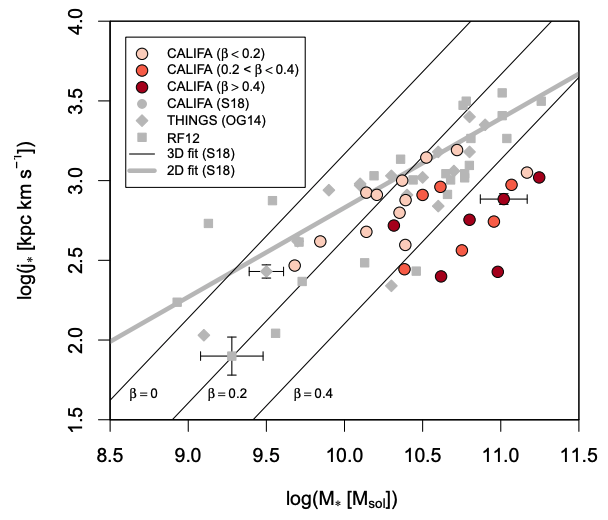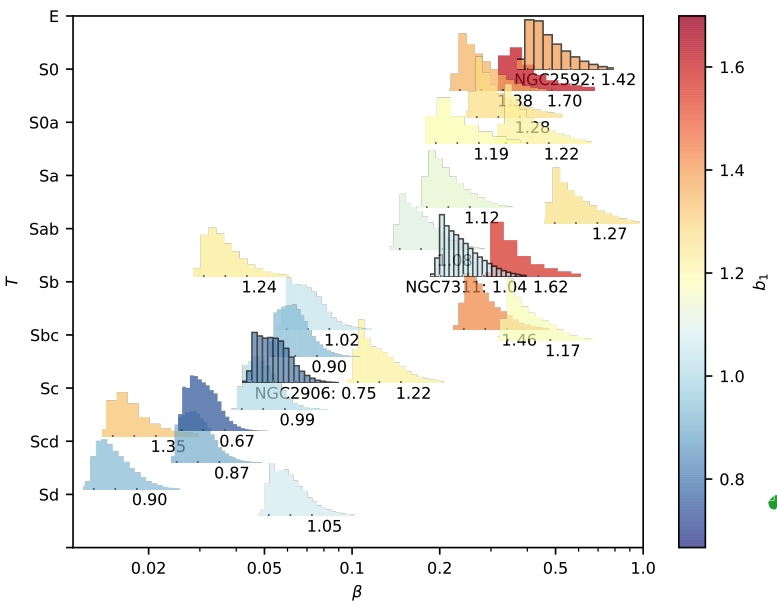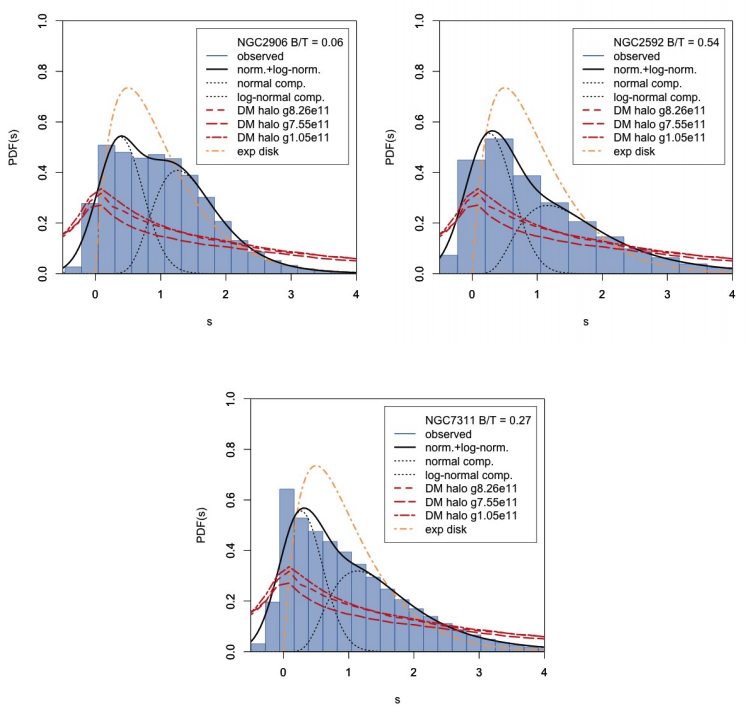First author
Multi-resolution angular momentum measurements of z~1.5-2 star-forming galaxies
Juan M. Espejo Salcedo, Karl Glazebrook, Deanne B. Fisher, Sarah M. Sweet, Danail Obreschkow, A. M. Swinbank, Steven Gillman, Alfred L. TileyAbstract: We present detailed stellar specific angular momentum (j∗) measurements of ten star-forming galaxies at z∼1.5−2 using both high and low spatial resolution integral field spectroscopic data. We developed a code that simultaneously models the adaptive optics (AO) assisted observations from OSIRIS/SINFONI along with their natural seeing (NS) counterparts from KMOS at spatial resolutions of [0.1−0.4] arcsec and [0.6−1.0] arcsec respectively. The AO data reveals 2/10 systems to be mergers and for the remaining eight the mean uncertainties Δ¯j∗ decrease from 49% (NS), and 26.5% (AO), to 16% in the combined analysis. These j∗ measurements agree within 20% with simple estimates (j∗~) calculated from the Hubble Space Telescope photometry and NS kinematics, however higher resolution kinematics are required to first identify these disks. We find that the choice of surface mass density model and the measurement of effective radius from photometry are the key sources of systematic effects in the measurement of j∗ between different analyses. Fitting the j∗ vs M∗ relations (Fall, 1983) with a fixed power-law slope of β=2/3, we find a zero-point consistent with prior NS results at z≥1 within ∼0.3 dex. Finally, we find a ∼0.38 dex scatter about that relation that remains high despite the AO data so we conclude it is intrinsic to galaxies at z>1. This compares to a scatter of ≤0.2 dex for disks at z≃0 pointing to a settling of the Fall relation with cosmic time.

Phenomenology of large scale structure in scalar-tensor theories: Joint prior covariance of ωDE, Σ and µ in Hordenski theories
Juan Espejo, Simone Peirone, Marco Raveri, Kazuya Koyama, Levon Pogosian, and Alessandra SilvestriAbstract: Ongoing and upcoming cosmological surveys will significantly improve our ability to probe the equation of state of dark energy, ωDE , and the phenomenology of large scale structure. They will allow us to constrain deviations from the Λ cold dark matter predictions for the relations between the matter density contrast and the weak lensing and the Newtonian potential, described by the functions Σ and μ , respectively. In this work, we derive the theoretical prior for the joint covariance of ωDE, Σ and μ, expected in general scalar-tensor theories with second order equations of motion (Horndeski gravity), focusing on their time-dependence at certain representative scales. We employ Monte Carlo methods to generate large ensembles of statistically independent Horndeski models, focusing on those that are physically viable and in broad agreement with local tests of gravity, the observed cosmic expansion history and the measurement of the speed of gravitational waves from a binary neutron star merger. We identify several interesting features and trends in the distribution functions of ωDE, Σ and μ, as well as in their covariances; we confirm the high degree of correlation between Σ and μ in scalar-tensor theories. The derived prior covariance matrices will allow us to reconstruct jointly ωDE, Σ and μ in a nonparametric way.
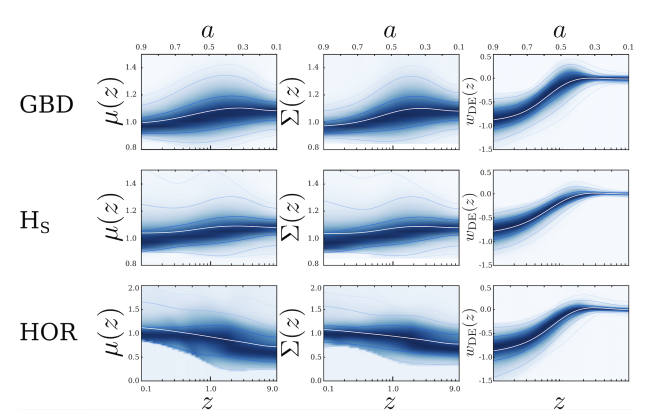
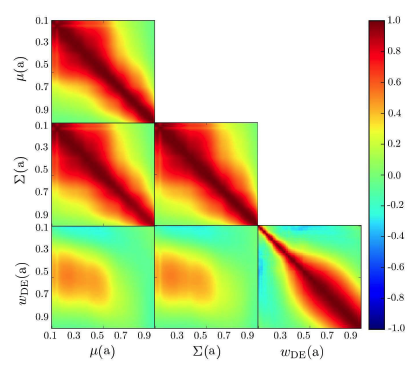

Contributor
Stellar angular momentum distribution linked to galaxy morphology
Sarah M Sweet, Karl Glazebrook, Danail Obreschkow, Deanne B Fisher, Andreas Burkert, Claudia D P Lagos, Juan M Espejo SalcedoAbstract: We study the spatially resolved stellar specific angular momentum j* in a high-quality sample of 24 Calar Alto Legacy Integral Field Area galaxies covering a broad range of visual morphology, accounting for stellar velocity and velocity dispersion. The shape of the spaxelwise probability density function of normalized s = j*/j*mean, PDF(s), deviates significantly from the near-universal initial distribution expected of baryons in a dark matter halo and can be explained by the expected baryonic effects in galaxy formation that remove and redistribute angular momentum. Further we find that the observed shape of the PDF(s) correlates significantly with photometric morphology, where late-type galaxies have a PDF(s) that is similar to a normal distribution, whereas early types have a strongly skewed PDF(s) resulting from an excess of low-angular momentum material. Galaxies that are known to host pseudo-bulges (bulge Sérsic index nb < 2.2) tend to have less skewed bulge PDF(s), with skewness (b1rb) ≲ 0.8. The PDF(s) encodes both kinematic and photometric information and appears to be a robust tracer of morphology. Its use is motivated by the desire to move away from traditional component-based classifications which are subject to observer bias, to classification on a galaxy’s fundamental (stellar mass and angular momentum) properties. In future, PDF(s) may also be useful as a kinematic decomposition tool.
